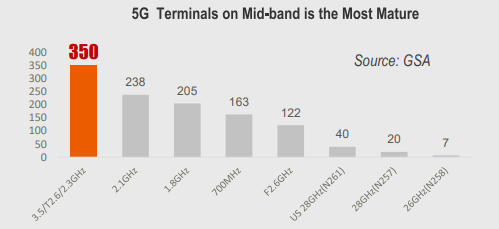Regulating the spectrum is vital to the mobility and connectivity surging within today’s data-heavy and tech-savvy generation. Allocation of spectrum through licenses guarantees flexibility to regulators to secure the best usage of the spectrum in society, and enables operators to offer innovative services with predictable quality service.
By 2024, the contribution of mobile technologies and services is expected to surge to 4.9% of the global GDP. For this to be achieved, sufficient spectrum resources for IMT/5G should be in place to provide the capacity for innovation and development. That being the case, the 6 GHz range that offers both capacity and coverage becomes significantly important. Being a pillar of digital transformation, 5G would need 1 to 2 GHz of additional mid-band spectrum for its future development. As an example, lack of mid-bands spectrum would require costly and sometimes non-economically viable network densification to offer the necessary capacity with continuous coverage. Thus, harmonization of the 6 GHz spectrum for IMT is imperative to sustain future capacity needs for affordable connectivity.
This is why a total of 23 telecom operators, vendors, and industry organizations released a joint 6 GHz IMT statement to recognize the importance of mid-band spectrums for IMT technologies.
The current investments on 5G networks have so far been focusing on mid-bands (the 3.3GHz-3.8GHz in particular). Reserving the spectrum around 6 GHz (at least 6425-7125 MHz) is essential to deliver the full potential of 5G-NR and its evolution in the future (i.e. 5.5G and 6G). Moreover, to avoid congestion and interference, allowing regulators to license the spectrum is the answer.
John Giusti, the GSMA chief regulatory officer has recently stated, “5G has the potential to boost the world’s GDP by $2.2 trillion. But there is a clear threat to this growth if sufficient 6 GHz spectrum is not made available for 5G.” However, without any harmonization in terms of spectrum regulation, various countries have taken action separately.
China intends to use the entire 1200 MHz in the 6 GHz band for 5G NR; Europe is considering to use the upper part for 5G NR with the 500 MHz in the lower part of the 6 GHz band already harmonized for unlicensed use (i.e. Wi-Fi 6E/NR-U); UAE and Morocco allocated limited unlicensed use to the lower 500 MHz of the band while Saudi Arabia allocated the full 6 GHz spectrum for such use.
Why does the 6 GHz licensed spectrum work better for operators and consumers alike? It is important to understand how 6 GHz licensing would address the demands for the years to come and provide benefits for the overall society.
Current Wi-Fi issues
Unlicensed spectrum, where Wi-Fi operates, has delivered significant benefits to users and has driven economic value worldwide. This is the reason why global support for Wi-Fi operation in a 6 GHz unlicensed spectrum continues to grow.
Yet, by making the 6 GHz band available for unlicensed use, some common Wi-Fi issues like lack of end-to-end security, difficulties in enforcing protection to other services operating in the same band, limited mobility support, and connections with non-guaranteed quality remain. Being license-exempt, any party can make use of a particular spectrum block, leading to unpredictable performance due to the concurrent asynchronous access to the same frequency resource.
Similar to being in a crowded hall, having a licensed spectrum is like having your own soundproof room. The operators’ and service providers’ ability to communicate becomes more reliable with better performance as unauthorized players cannot access that band without permission.
In this way, the reliability of a wireless network like Wi-Fi can be threatened by the shared nature of unlicensed spectrum. Thus, to meet the growing network capacity demands and improve stability, MNOs, WISPs, and enterprises now look beyond Wi-Fi-based connectivity solutions to protect their links and ensure uptime.
Licensed 6 GHz is the next C-band
C-band sits between the 2.4 GHz and 5 GHz Wi-Fi bands. Its security, capacity, coverage and other characteristics have been well established, making it the most popular 5G band in the world.
The 3GPP has defined three bands for C-band (band n77, band n78, and band n79). Most European and Asian countries currently use n78, which stretches from 3.3 to 3.8 GHz, while the US and Japan use n77, a larger band from 3.3 to 4.2 GHz.
Estimating the mid-band spectrum needs in the 2025-2030 timeframe, the 6 GHz range is a core opportunity to address the spectrum needed to ensure the future 5G connectivity. 6425-7125 MHz is a priority band for mobile network operators globally as they look to increase capacity and lower deployment costs.
Aiming to be the next C-band, licensed 6 GHz is ideal for the commercial success and deployment of 5G NR, 5.5 G, and 6G in the future. In particular, an additional 1 to 2 GHz of mid-bands spectrum would be required to meet the IMT-2020 user experienced data rates of 100 Mbit/s on the downlink and 50 Mbit/s on the uplink in cities with a high density of population. This is defined by the ITU-R for citywide high capacity coverage.
This additional spectrum would not only help to address the connectivity needs in densely populated cities, but it will also benefit MNOs in lower population density areas to optimize network investment and lower the cost per bit. 5G FWA in mid-bands also reduces the connectivity cost compared to FTTH for unconnected areas. As a result, the average cost of 5G FWA connectivity of 100 Mbit/s in rural households such as villages or small towns and will sustain the substantial capacity required on roads.
The 5925-7125 MHz range can strongly address the expected need for more mid-bands spectrum in the 2025-2030 timeframe. Countries with a well-developed fiber, cable, or DSL broadband access network should make the 6425-7125 MHz band available for 5G to deliver the IMT-2020 requirements. In countries that rely heavily on wireless for connectivity, the future use of the entire 5925-7125 MHz for 5G and its evolution would produce the greatest socio-economic benefit.










